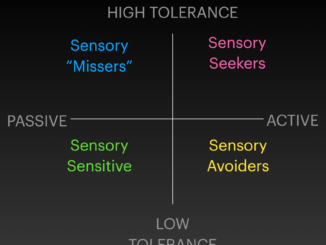In my recent experiment with consulting with a few people via email, I received this lovely question! The asker was asking about their child specifically, and their child is a young adult. However, the specifics of this question could apply to any child who is learning to use AAC to talk!
Q: My child uses AAC (augmented/alternative communication) to talk, in the form of a tablet that can speak when he presses buttons. He has recently discovered that he can push the same button over and over to say the same word 20-30 times in only a few seconds. He is laughing and joyful about it. I don’t want to discourage that! However, it’s very hard for me to tune out all the sound.
Here was my answer.
My first thought is that I don’t know if you know of some groups on FB that I highly, highly recommend and love: one is called “AAC Through Motivate, Model, Move Out Of The Way” and one is called “Ask Me, I’m an AAC user! (24 Hour Rule!)” The latter is moderated specifically by adults who speak using AAC and both of them have been utterly invaluable in me learning about things like the preferred etiquette of AAC use and modeling and all of that by adults who actually use it.
If you learn from FB groups at all, I’d recommend both of those to you.
I can totally see how hearing that many words all at once would be overwhelming! I’m also an auditory sensory sensitive person and that would be quite a lot to manage. In fact…I’ve written recently about how my own kids repeating words over and over has driven me to be snappy with them in a way that I don’t even like in myself, nor do I want to keep doing. And that’s exactly the same thing it is with your son, even if it sounds like it’s different because he’s using AAC. If he was a baby and he was babbling or squealing in a way that bothered you, that would be the same thing. If he was a child and he was going “mom mom mom mom mom” in a way that bothered you, that would be the same thing.
It’s also very common for learners of a new AAC, when they connect with the AAC for the first time, to go through a period of “babble” the same way that children learning spoken words do. This might sound like pushing the same word over and over and over, or playing with the words in a creative way that doesn’t exactly approximate spoken speech but more like “stimming” or playing with words. 🙂
What can you do? You could do what I do a lot of the time and wear earplugs or headphones to help tone it down. Another thing that helps me is having a different sound playing in the house — like familiar, soft music — I sometimes choose piano music and play it on the Alexa or through a speaker, so that my brain has a sound to latch on to that doesn’t feel so jarring and threatening.
In our sensory systems, sensory input that is anticipated and expected and the same over and over and we are in control of it feels soothing and regulating, while sensory input that is unanticipated, unexpected, different over and over, or we are not in control of it, often feels jarring (if it feels bad) or alerting/exciting (if it feels good). It sounds like because you are not in control of the sound from his AAC and you’re being subjected to so much of it all at once, it feels jarring and alerting (in an uncomfortable way) to your brain, which makes it just feel…bad. That makes perfect sense! It makes sense that you feel that way. And also, it’s okay to take steps to protect and sooth that part of your brain — like by muffling the sound a little bit, or going into another room, or having a different sound to distract your brain. You don’t have to engage with his play 100% of the time.
Depending on his cognitive abilities, you could also always talk with him about it. Whether that means asking him to turn the sound a little lower on his device (the same way you’d ask a child if they could moderate their volume, or teach them how) or letting him know that you need to step out for a few minutes or letting him know that you are going to wear headphones to listen to some music or whatever it is.
You may already know this, but I’d be remiss if I didn’t point out that you should not turn off his device, or take it away from him, or program it to speak/respond slower, or anything like that. I don’t get that sense from your email at all — but there are parents who do that, and there are even therapists who recommend that, so I can’t answer without saying please don’t do that to him! It’s literally his voice, and therapists wouldn’t say “duct tape your speaking child’s mouth shut if they annoy you,” but for some reason some therapists think it’s appropriate to take away a child’s speech device or program it to respond more slowly so it doesn’t annoy them. (I have worked with some in the past! It was rough!)
This is really at its heart a question about how to balance opposing sensory needs — need for quiet (or at least need for not quite this much loud), and need for auditory stimming/exploring voice! So really, it sounds a little bit overly simplistic, but the options can really be boiled down to: go in separate spaces so separate sensory needs can be met separately, or use accommodations/modifications to stay in the same space if going to separate spaces isn’t possible.



